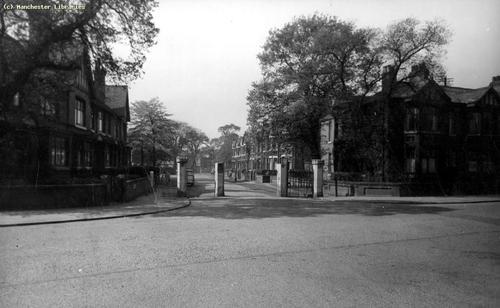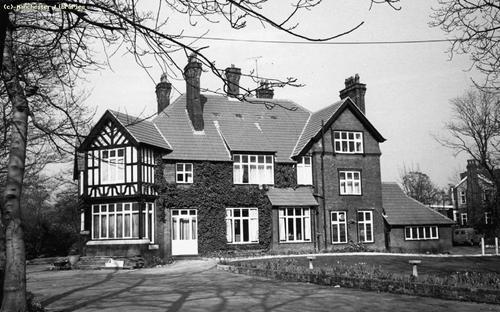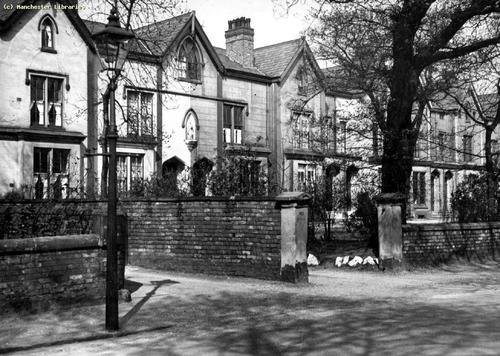Spath Lane Annie, as she was known to bus crews, travelled daily from Handforth to Manchester. She was elderly and it was said that her daily commute was in order to visit the Housing Department at the Town Hall to berate them for rehousing her in Handforth. We never heard if she won her argument for a return to the city but after several years as a regular traveller, she disappeared from the scene and the Handforth public could breathe easily again. Annie would always push her way to the front of the queue in order to claim her seat on the nearside front row. Woe betide anybody who dared occupy it.
The woman standing at the bus stop opposite The Rex in Wilmslow didn't seem to know whether to stop the bus or not but we pulled up anyway. Are you waiting for the bus?, I asked. well, I don't know, I am staying at the Stanley Hotel. Come aboard then, we're going your way. I collected her fare but had to tell her when she had arrived even though she was looking at the hotel through the window. Dora Bryan proved to be just as unworldly in real life as in the roles that she played on stage and screen.
It was at the Spath Lane stop in Handforth where we pulled up one day on the way to Manchester to let three passengers and a dog aboard. I assumed the black labrador was with one of the people until it took its own seat towards the back of the bus. It stared out of the window and completely ignored my attempts to move it. Only as we reached The Griffin at Heald Green did it leave the seat; it had arrived at its destination. My driver, John Platt told me that when he had been based at Stockport, he often drove on the 358 route to Hayfield. Every day, a dog would be waiting at Birch Vale. The drivers all knew the dog and would always stop. Attached to its collar was a small purse containing a few coins. The conductor would take the appropriate fare and leave a ticket in exchange. The dog rode to Hayfield where after a brief look around he would wait for the next bus home.Back at Heald Green on another occasion, I could see a woman struggling to board the bus. She had stepped on to the platform with two heavy bags but her shopping trolley was still at the kerbside. I carried it aboard but even I strained to lift it. What have you got in there, I quipped, house bricks ? She opened the lid to show me that it was indeed full of bricks !
Breakdowns weren’t uncommon and sometimes gave a welcome break from routine. On one occasion, I was working with driver Jack Plant on the 29 route into Manchester. We reached the southern end of Upper Brook Street before we realised that we could travel no farther. We transferred our passengers to a Selnec No 50 and phoned for help. It was clear that it would be a good while before relief arrived but fortunately we had stopped opposite the Plaza Cafe. This establishment was renowned for its biryanis and was popular with students. They provided us with a welcome cup of coffee. Refreshed, we returned to the bus to wait for help but not before exploring an adjacent derelict house. It was awaiting demolition but it was evident that it had been recently occupied. In the back yard were two “mountains”, one of wine bottles, the other of dog food cans. The occupants hadn’t followed a healthy diet !
One evening in January 1976, we set out from Macclesfield for Manchester on the 29 route. The weather was dreadful and we saw very few passengers. Reaching the motorway bridge on Manchester Road in Cheadle, my driver stopped to compare notes with the crew of the inbound service. The bus, a single decker, was rocking so violently that it felt as though it would be lifted off of the bridge. We made it safely to Piccadilly but as we left and turned into Portland Street, sheets of corrugated iron were flying through the air at head height. These were the hoardings from the Arndale Centre, then under construction on Market Street. We reached Alderley Edge where we were stopped by police who told us that the road ahead was blocked by fallen trees. Our journey back to Macclesfield was completed by taking the Wizard route. Despite the hurricane “Capella” we returned early to the Bus Station.
Frank was a pleasant, inoffensive man but his earlier mental health problems meant that he could sometimes be a touch erratic. On one journey out of Macclesfield, I was still collecting fares when I realised that the bus had come to a standstill. We were in Longacre Street which, although parallel to our correct route, was too narrow for a big green double decker. Despite all else, Frank was a skilled driver and eventually managed to manoeuvre the bus around a very tight turn. Another day, we had arrived in Cheadle 10 minutes early. I told Frank that we would have to wait our time but he was having nothing of it. “You want a cup of tea in Town don’t you? Leave it to me and you’ll be alright” We arrived in Piccadilly nearly 20 minutes before time and left 5 minutes late. Plenty of time for a brew and nothing more was said.
Crosville in their wisdom, sent a diminutive single decker from Chester to relieve a vehicle shortage at Macclesfield. I can’t remember what model it was but it was probably an old Bristol. It was a curiosity and was soon dubbed “A Puddle Jumper”. It was parked at the back of the garage, unwanted and of little use. A few days later, I was spare conductor and heard that a bus had broken down and we needed to pick up school children from Nether Alderley School. This was a “one man” duty and neither I, nor the driver knew the route. “Take the Puddle Jumper, it’s all I’ve got” said Neville, the garage driver. We protested but he was determined that we should take it. We headed out towards the Wizard and had been told that a left hand turning lead down towards the school. The road we took however, led us through some huge ornamental gates where we were faced with the home owner driving out in his Bentley. It must have been quite a shock for him to come face to face with this green monster which was rapidly becoming enveloped in a cloud of steam as the radiator overheated. We managed to extricate ourselves and limp down to the school. We eventually completed the journey but I don’t suppose the engine suffered too much.
The bane of every busman’s life was Miss Johnson. An elderly woman who travelled regularly from Bollington to Macclesfield. On arrival at the bus station, her first call was invariably at the office in order to register her latest complaint. Her role in life – to make everybody as miserable as herself.
I worked as a bus conductor from the Macclesfield garage of Crosville Motor Services from about 1972 until 1979 when all remaining services converted to one man operation.


























































